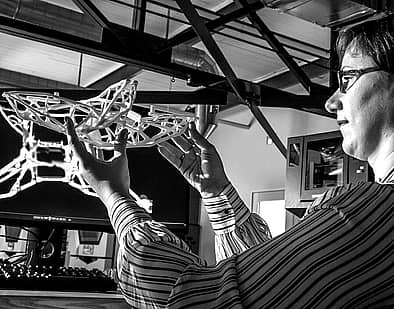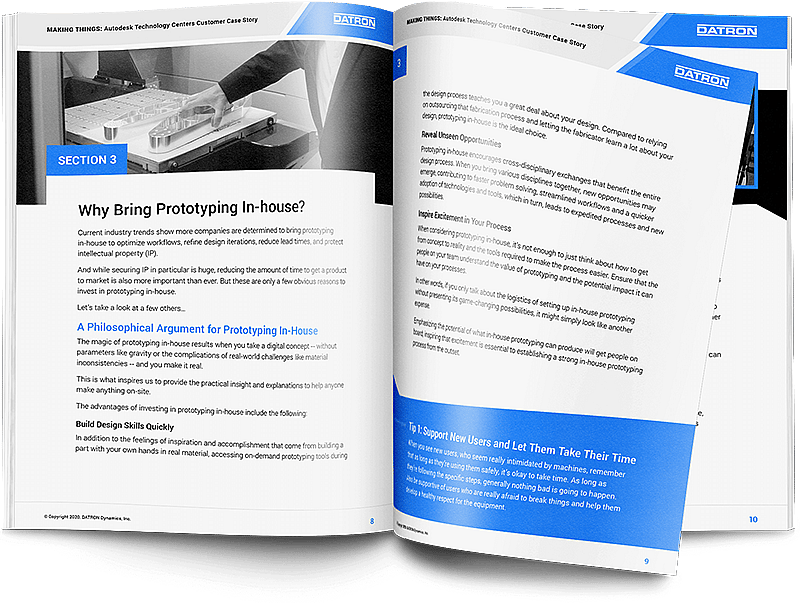Rapid Prototyping In-House
Current industry trends show more companies are determined to bring rapid prototyping in-house to optimize workflows, refine design iterations, reduce lead times, and protect intellectual property (IP).
And while securing IP in particular is huge, reducing the amount of time to get a product to market is also more important than ever. But these are only a few obvious reasons to invest in prototyping in-house.
Let’s take a look at a few others…
A Philosophical Argument for Rapid Prototyping In-House
The magic of prototyping in-house results when you take a digital concept—without parameters like gravity or the complications of real-world challenges like material inconsistencies—and you make it real.
The advantages of investing in prototyping in-house include the following:
Build Design Skills Quickly
In addition to the feelings of inspiration and accomplishment that come from building a part with your own hands in real material, accessing on-demand prototyping tools during the design process teaches you a great deal about your design. Compared to relying on outsourcing that fabrication process and letting the fabricator learn a lot about your design, prototyping in-house is the ideal choice.
Reveal Unseen Opportunities
Prototyping in-house encourages cross-disciplinary exchanges that benefit the entire design process. When you bring various disciplines together, new opportunities may emerge, contributing to faster problem solving, streamlined workflows and a quicker adoption of technologies and tools, which in turn, leads to expedited processes and new possibilities.
Inspire Excitement in Your Process
When considering prototyping in-house, it’s not enough to just think about how to get from concept to reality and the tools required to make the process easier. Ensure that the people on your team understand the value of prototyping and the potential impact it can have on your processes.
In other words, if you only talk about the logistics of setting up in-house prototyping without presenting its game-changing possibilities, it might simply look like another expense.
Emphasizing the potential of what in-house prototyping can produce will get people on board; inspiring that excitement is essential to establishing a strong in-house prototyping process from the outset.
Start Strong
Setting up your own prototyping lab with new people, processes, and technology might seem daunting. Ultimately, “humanize” the process as much as possible.
Focus on the people involved and the resources available to you. Work with your team to build confidence, earn early wins, and achieve success at the start. Collaborate with other companies in your region or community by building bridges to advance both your own goals and knowledge base—and help your industry take important steps forward.
When you’re just beginning to prototype in-house, there are a few practical things you can do to help establish strong processes from the outset.
These might include:
Achieve Early Success
After you’ve created excitement with your team about bringing prototyping in-house, consider the experience you’re about to create—especially when embarking on this process for the first time.
Avoid overwhelming them by beginning with laying out a simple workflow. By starting from the design and working towards the finished part, you can illustrate the process of prototyping in-house clearly. Choose something your team is already working on day-to-day to demonstrate the accessibility and ease of both the process and the equipment.
Make Things People Want to Interact With

The goal is to make things that people want to interact with in a useful way and prototyping is the most authentic way to test that. A physical proto
type allows you to look at a part from all angles and feel it in your hands, bringing you closer to the experience of the end user.
Make it Easy to Start
To support excitement, early success, and eager adoption, it helps if your prototyping process and tools are turnkey and easy to use. New users need an accessible entry point in order to feel empowered and build confidence.
Therefore, it’s important they have a swift, positive feedback loop (first project) that will reinforce the importance and value of using the tools, which will motivate them to learn and use additional tools (build confidence) with increasing complexity.


